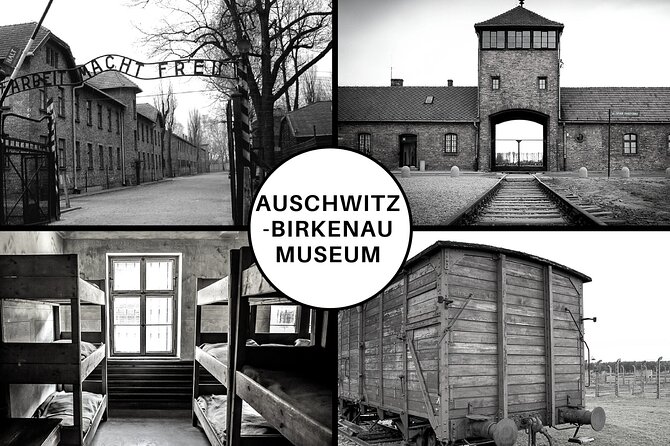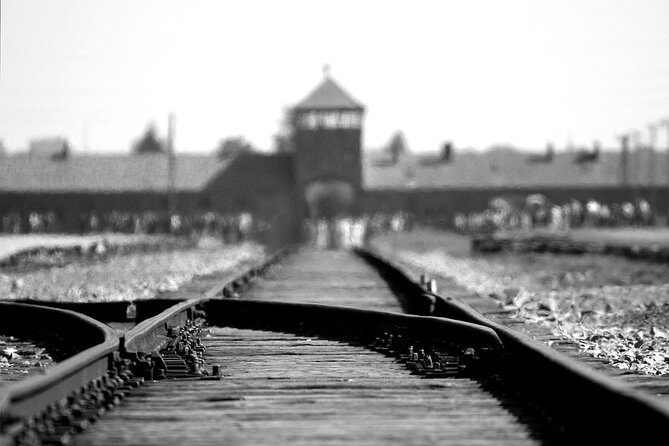Visiting Auschwitz-Birkenau, the notorious Nazi concentration camp complex, is a solemn and profound experience. This guided tour offers an in-depth exploration of the site, providing visitors with a comprehensive understanding of its dark history. Led by professional guides, the tour includes entry tickets to both Auschwitz I and Birkenau, allowing guests to witness the haunting remnants of gas chambers, barracks, and other structures that bear witness to the unspeakable atrocities committed there. Through this experience, visitors can honor the memory of those who perished and reflect on the enduring lessons that this tragic chapter in human history has to offer.
This experience made our list of the 7 Best Tours In Oswiecim.
Key Points

- The guided tour of Auschwitz-Birkenau provides a comprehensive introduction to the Nazi concentration camp complex and its somber history.
- The tour includes entry tickets to both Auschwitz I and Auschwitz II-Birkenau camps, allowing visitors to explore the haunting remnants of the site.
- The tour is led by professional guides who share historical details and firsthand accounts, offering a deeper understanding of the atrocities committed.
- The tour is not wheelchair accessible and requires a moderate level of physical fitness, with limited luggage and modest dress expected.
- The tour has a cancellation policy that includes full refunds for cancellations made at least 24 hours in advance, with no refunds for late arrivals or no-shows.
Overview of the Auschwitz-Birkenau Tour

The Auschwitz-Birkenau tour provides visitors with a comprehensive introduction to the notorious Nazi concentration camp complex, guiding them through the site’s somber history and preserving the memory of those who perished there.
Led by professional guides, the tour includes entry tickets to both the Auschwitz I and Birkenau (Auschwitz II) camps, allowing guests to explore the haunting remnants of gas chambers, barracks, and other structures that stand as stark reminders of the atrocities committed.
Throughout the experience, the guides share poignant details and historical context, offering a deeper understanding of this profoundly tragic chapter in human history.
The tour’s modest dress code and limitations on luggage size reflect the solemnity of the site.
Here are more great tours and experiences we've reviewed in Oswiecim
Inclusions and Meeting Point

The Auschwitz-Birkenau tour includes a professional guide who leads visitors through the site.
Guests meet at the Memorial and Museum Auschwitz-Birkenau, located at Więżaniów Oświęcimia 55, 32-600 Oświęcim, Poland.
The tour isn’t wheelchair accessible, and a moderate level of physical fitness is required.
Travelers should note that tour timings may change, and they should confirm the exact start time 1-2 days in advance.
Plus, luggage is limited to a maximum size of 30x20x10cm, and modest dress is expected.
The tour group size is capped at 30 travelers to ensure a personalized experience.
Important Information
Confirmation of booking is received upon purchase, and tour timings may change, so travelers should confirm the exact start time 1-2 days prior to the visit.
The tour is located near public transportation but isn’t wheelchair accessible, requiring a moderate level of physical fitness. Luggage is limited to a maximum size of 30x20x10cm, and modest dress is expected.
Groups are capped at 30 travelers to ensure a personalized experience. There’s a minimum number of travelers required, and if this isn’t met, travelers may be offered an alternative or a full refund.
Changes within 24 hours of the tour aren’t accepted, but a full refund is provided if canceled at least 24 hours in advance.
Cancellation Policy
According to the cancellation policy, travelers can receive a full refund if they cancel at least 24 hours in advance. However, no refund is provided for cancellations made less than 24 hours prior to the tour. Plus, changes to bookings within 24 hours of the scheduled tour aren’t accepted.
The cancellation policy also states:
- A minimum number of travelers is required for the tour to proceed
- If the minimum isn’t met, travelers may be offered an alternative tour or a full refund
No refunds are given for no-shows or late arrivals. All refunds are subject to the tour operator’s discretion.
Exploring Auschwitz-Birkenau
Visiting Auschwitz-Birkenau, a former Nazi concentration camp, offers a profound and sobering experience for many travelers.
The guided tour provides an opportunity to learn about the harrowing history of this site and pay respects to the millions who suffered and perished there.
Visitors will see the infamous ‘Arbeit Macht Frei‘ gate, the barracks, gas chambers, and crematoriums that once operated at the camp.
The tour guides share firsthand accounts and historical details, shedding light on the horrors of the Holocaust.
While a difficult and emotionally challenging experience, touring Auschwitz-Birkenau is an important way to honor the victims and reflect on the lessons of the past, ensuring such atrocities are never repeated.
Loving the local insights? Here are more guided experiences we recommend in Oswiecim
- From Krakow: Auschwitz-Birkenau Guided Tour & Pickup Options
- Entrance Ticket to Auschwitz Birkenau With Guide and FREE Ebook
- Skip-the-Line Entry and Guided Tours, Auschwitz-Birkenau Camps – Oswiecim
- Ticket Pass and Guided Tour in Auschwitz-Birkenau Museum
- Auschwitz and Birkenau Guided Tour With Fast Track Tickets
Guided Tour Highlights
The guided tour of Auschwitz-Birkenau entails a comprehensive look at the former Nazi concentration camp, guiding visitors through its harrowing history and key landmarks.
The tour highlights include:
- Viewing the infamous ‘Arbeit Macht Frei’ gate at the entrance of Auschwitz I
- Exploring the Auschwitz I camp, including the prisoners’ barracks and gas chambers
- Visiting the Auschwitz-Birkenau extermination camp, the largest of the Nazi death camps
The tour is led by knowledgeable guides who provide historical context and important details, ensuring visitors gain a deeper understanding of this tragic chapter in history.
Learning about the atrocities committed and the stories of those who perished at these sites is a crucial part of the tour.
Historical Context

The Auschwitz-Birkenau complex was the largest of the Nazi German concentration camp network, established during World War II in occupied Poland. It became a major site of the Holocaust, where over one million Jews, as well as Roma, Soviet prisoners of war, and Polish political prisoners, were murdered.
The camp consisted of three main parts: Auschwitz I, the main camp; Auschwitz II-Birkenau, a combined concentration/extermination camp; and Auschwitz III-Monowitz, a labor camp to staff an IG Farben factory.
Today, the Auschwitz-Birkenau Memorial and Museum stands as a somber reminder of the atrocities committed, dedicated to preserving the memory of those who perished and educating visitors about the horrors of the Nazi regime.
Preparing for the Visit
Visitors should expect a profound and moving experience when embarking on the guided tour of Auschwitz-Birkenau, as they explore the somber history and haunting remnants of one of the most notorious sites of the Holocaust.
To ensure a respectful and meaningful visit, it’s crucial to review the important information provided:
- Modest dress is expected, as the site is a memorial, and visitors should avoid wearing anything too casual or revealing.
- Luggage is limited to a small size, as larger bags and suitcases aren’t permitted.
Visitors should arrive at the designated meeting point on time, as the tour follows a tight schedule.
A moderate level of physical fitness is required, as the site covers a large area and involves walking.
Frequently Asked Questions
Can I Take Photographs During the Tour?
Visitors are typically allowed to take photographs during guided tours, though some sites may have restrictions or guidelines. It’s best to check with the tour operator or venue beforehand to understand any photography policies.
Is the Tour Available in Other Languages?
The tour is available in multiple languages, including English, Polish, German, and others. Visitors can inquire about language options when booking or upon arrival to ensure a guided tour in their preferred language.
What Should I Bring With Me on the Tour?
Visitors should bring a small backpack or purse with essentials like a water bottle, snack, and any necessary medications. Avoid bringing large bags or luggage, as they may not be allowed on the tour. Dress in comfortable, modest clothing.
How Long Does the Guided Tour Usually Last?
The guided tour typically lasts around 3-4 hours. This includes time to explore the museum and memorial sites. The duration may vary depending on factors like group size and pace. Visitors should plan accordingly and allow sufficient time for the full experience.
Are There Any Age Restrictions for the Tour?
The guided tour at Auschwitz-Birkenau doesn’t have any age restrictions. However, the tour requires a moderate level of physical fitness, so very young children or elderly visitors may find it challenging. The tour is not wheelchair accessible.
Recap
The Auschwitz-Birkenau tour provides a harrowing yet necessary experience, allowing visitors to bear witness to the horrors of the past and honor the memory of those who perished.
Through the guided exploration of the camp’s somber remnants, this tour offers a profound opportunity to reflect on the lessons of history and commit to ensuring such atrocities never occur again.
